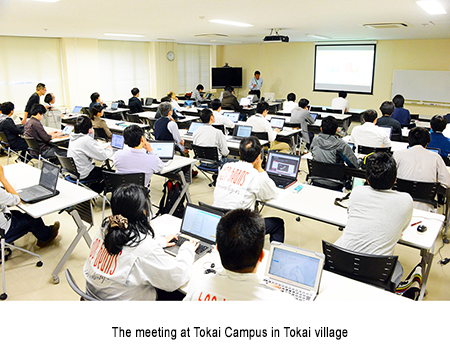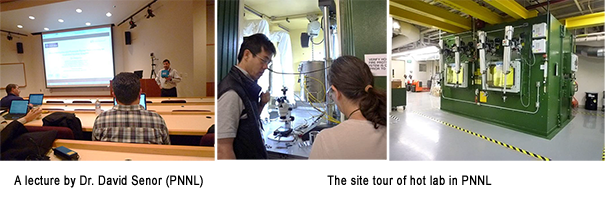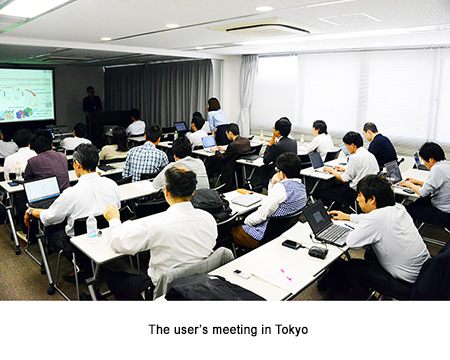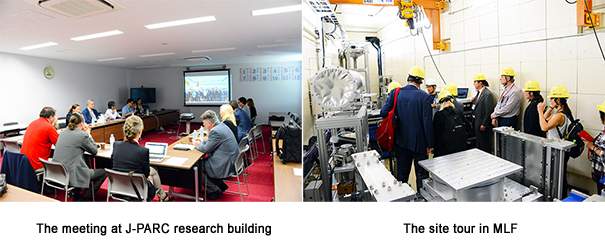| ■ J-PARC News - October 2016 (Issue #138) |
| ● Awards Received for Experimental Results Using J-PARC |
|---|
| - Research results at the Hadron Experimental Facility - |
| Dr. Yudai Ichikawa, Researcher at the Japan Atomic Energy Agency (JAEA), recently received the Young Researcher Award from the 22nd Nuclear Experimental Physics Forum, an experimental community for research on nuclear physics, for his "Research on Strange Dibaryons Using the d (Π +, K+) reaction at J-PARC." This research was the result of experiments conducted at J-PARC's Hadron Experimental Facility in 2012, in which an attempt was made to produce a bound state of two protons and an anti-K-meson (a topic in nuclear physics for many years) by irradiating deuterons with a Π meson beam. This was done to investigate the state called a "Kaonic nuclei" in which an anti-K-meson is added to the constituents of an atomic nucleus. Through this experiment, results were obtained suggesting the existence of a kaonic nuclei state, and it was found that the binding energy of that state is a bond energy about 10 times the bond energy of a proton and neutron in an ordinary nucleus. |
| - Research results using neutron instruments at the Materials and Life Science Experimental Facility (MLF) - |
| Every two years, the President of the Japanese Society for Neutron Science makes a "President's Choice" from all science articles, feature articles and other articles published in the journal Hamon ("Ripples") published by the society. This time, the President's Choices were selected from articles published from the November 2014 issue to the August 2016 issue, and the winners were four papers on experiment results using MLF neutron instruments: BL03 "iBIX," BL08 "SuperHRPD," BL11 "PLANET," and BL21 "NOVA." The persons involved will be commended at the annual meeting of the Japanese Society for Neutron Science, held in December of this year. The published papers, the involved instruments, and other information are indicated below. |
|
| ● Measurement System Research Meeting 2016 (October 13-14, Tokai Campus, High Energy Accelerator Research Organization (KEK)) |
|---|
| - Current Situation and Future Prospects for Development of Measurement Systems in Experiments Using High-Intensity, High-Brightness Beams - |
| This research meeting is held to provide opportunities for collaborative activities, with system developers active in various fields meeting at a single venue, and engaging in information exchange and discussion regarding the current state and future prospects for system development. This was the second time this event has been held, following two years ago. There were 84 participants, including many developers with an interest in development of systems for the purpose of utilizing high-intensity, high-brightness beams in areas such as elementary particle and nuclei experiments, physical properties experiments, and accelerator control. There were 31 presentations, and the closing message stressed the importance of cooperation and mutual enhancement in cases where collaborative use is possible. |
| |

 * Click here to enlarge. * Click here to enlarge. |
| |
| ▲to Page Top |
| |
|
| ● 3rd RaDIATE Collaboration Meeting (September 7-9, PNNL, U.S.) |
|---|
| A steering meeting of RaDIATE (Radiation Damage in Accelerator Target Environment) in the process of international collaboration by 11 institutions worldwide at present was held for three days with about 30 participants in early September at PNNL (Pacific Northwest National Laboratory) in the U.S. Some presentations at the meeting were given via a teleconferencing system. This international collaboration involves cooperative research on radiation damage from accelerators in beam target environments, and in this fiscal year, progress is being made in procedures involving J-PARC and CERN (European Organization for Nuclear Research). This time, as participants from J-PARC, there were two staff in charge of evaluating items such as beam window and target materials of the Neutrino Experimental Facility, and damage to target vessel materials for the MLF neutron source. There was discussion and coordination with experts from various research institutions in the U.S. and Europe regarding these irradiation testing plans, related preparations, post-irradiation testing plans and other topics, and a great deal of valuable information was obtained. The next meeting is scheduled to be held at J-PARC. For details, |
| please see: http://radiate.fnal.gov/index.html |
| |

 * Click here to enlarge. * Click here to enlarge. |
| |
| ▲to Page Top |
| |
|
| ● FY2016 Users' Meeting on the TAKUMI Engineering Materials Diffractometer (October 20, Shinagawa, Tokyo) |
|---|
| Persons involved with BL19 TAKUMI, the Engineering Materials Diffractometer of the MLF, held a users' meeting for person's with use experience in order to examine instrument enhancement. At the start of the meeting, Dr. Kazuya Aizawa, Leader of the Technology Development Section of the Materials and Life Science Division, and the person responsible for the TAKUMI instrument, explained the purpose of holding the meeting, and gave an overview of the background and current situation of TAKUMI. There were 25 participants, and 13 presentations on the results of previous use experiments and other matters. Attendees discussed topics such as improvement of ease-of-use based on use experiments and equipment for the environment around specimens to be developed in the future, and shared information on results or interest to users. |
| TAKUMI first received a neutron beam generated using a 4 kW proton beam in October 2008, and in January 2009, user experiments were started at 20 kW. Since then the instrument has been utilized by a wide range of users from universities, national laboratories, and industry, for purposes such as measurement of residual stress of steel materials, evaluation of deformation in such cases, and measurement of residual stress of superconducting conductors, which are composite materials. |
| |

 * Click here to enlarge. * Click here to enlarge. |
| |
| ▲to Page Top |
| |
|
| ● Delegation from Sweden Visits J-PARC (October 4, J-PARC Research Building) |
|---|
| Twelve members of a delegation from the MIRAI Project, including staff from Lund University of the Kingdom of Sweden, visited J-PARC on October 4. The MIRAI Project is a consortium of 17 universities in Sweden and Japan, and its purpose is the promotion of research cooperation between the two countries, and the development/exchange of young researchers. At present, the European Spallation Source (ESS) is under construction in Sweden, with operation scheduled for FY2019, and an academic research district is being formed centered on this large research facility. At the meeting, overviews were given of the J-PARC facilities and MIRAI Project, and there was an exchange of views on the possibility of research cooperation between J-PARC and relevant institutions in Sweden. After the meeting, the delegation toured the experimental facilities of J-PARC, and at the MLF they observed instruments used for neutron and muon experiments. |
| The delegation visited KEK on the following day, October 5. For details, please see the KEK home page.http://www.kek.jp/en/NewsRoom/Release/20161017142200/ |
| |

 * Click here to enlarge. * Click here to enlarge. |
| |
| ▲to Page Top |
| |
|
| ● Facility Updates (summer maintenance) |
|---|
| (1) At the 3 GeV synchrotron (RCS), the replacement work was carried out for the beam collimator at the most downstream. |
| (2) At the Materials and Life Science Experimental Facility (MLF), a neutron guide tube was set up in the BL23 beamline. |
| (3) At the 50 GeV synchrotron (MR), the acceleration cavity was replaced with a high-gradient cavity. |
| |

 * Click here to enlarge. * Click here to enlarge. |
| |
| ▲to Page Top |
| |
|
| ● Ozora Marche at the Daijingu Shrine and Muramatsu-san Kokuzodo Temple (October 8, Tokai Village) |
|---|
| The Ozora Marche is held every year by the Tokai Sightseeing Guide as an event for communicating the attractions of the culture and history of Tokai Village to younger generations. J-PARC began exhibiting at Ozora Marche from two years ago, and continued this year with a Science Experiment Corner where visitors could experience things like the world of low temperatures and experiments using magnetic force. Visitors lines up to see the "Super-Conducting Rollercoaster" experiment, where a superconductor magnet cooled with liquid nitrogen at -196℃ runs on rails, and the presentation was enjoyed by everyone from children to adults. |
| |
 |
| |
| ▲to Page Top |
| |
|
| ● KEK Science Cafe "The Extraordinary Power of Waves" (October 7, 14, 21, 28, BiVi Tsukuba) |
|---|
| Starting at 7:00 p.m. every Friday, the High-Energy Accelerator Research Organization (KEK) is holding a Science Cafe at the Tsukuba General Information Center (Mingling Lounge) of BiVi Tsukuba. In October, J-PARC public relations advisor, Dr. Shinichi Sakamoto of the J-PARC Public Relations Section, was invited and he spoke for four weeks on the topic of waves. Using a straw wave machine and water waves, he reproduced phenomena which occur with all waves, such as diffraction and interference, and from that starting point he elucidated the "waves" hidden under the surface of advanced science in areas such as neutrino oscillation and gravity waves. As always, many students and older people participated, and as the sessions progressed, Dr. Sakamoto was frequently peppered with questions. For the participants, this was a good opportunity to understand advanced research while having fun. |
| |
 |
| |
| ▲to Page Top |
| |
|
| ● 2nd Class to Experience Chigiri-e, Images Made with Torn Japanese Paper (September 30, KEK Tokai Dormitory) |
|---|
| The collaboration meeting for the T2K (Tokai to Kamioka) experiment held in Tokai Village is always attended by many researchers from overseas. A class to experience chigiri-e was held during the lunch break to coincide with the meeting at the end of September. Fifteen researchers from overseas participated in the class, and after listening to the staff's explanation of how to make chigiri-e, they each selected their own motifs such as animals and plants, and experienced chigiri-e. The participants concentrated on creating their own works, while looking at samples, and finished in about one hour. The designs available this time were persimmons, grapes, cherries, camellia, autumn leaves, and goldfish, and many participants chose camellia and autumn leaves. Some participants even produced two works. |
| |

 * Click here to enlarge. * Click here to enlarge. |
| |
| ▲to Page Top |
| |
|
©2016 J-PARC Center. All rights reserved.
|
|